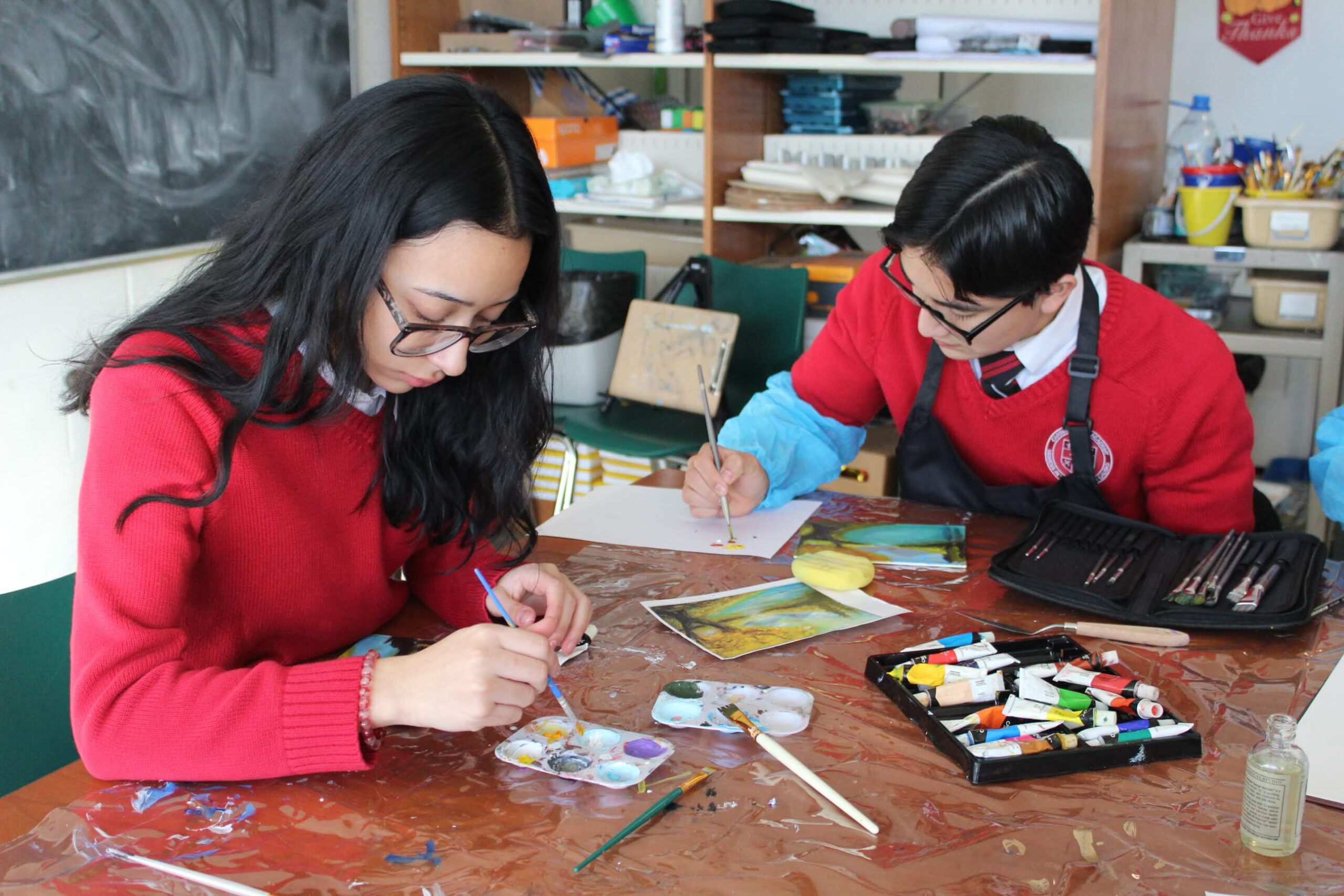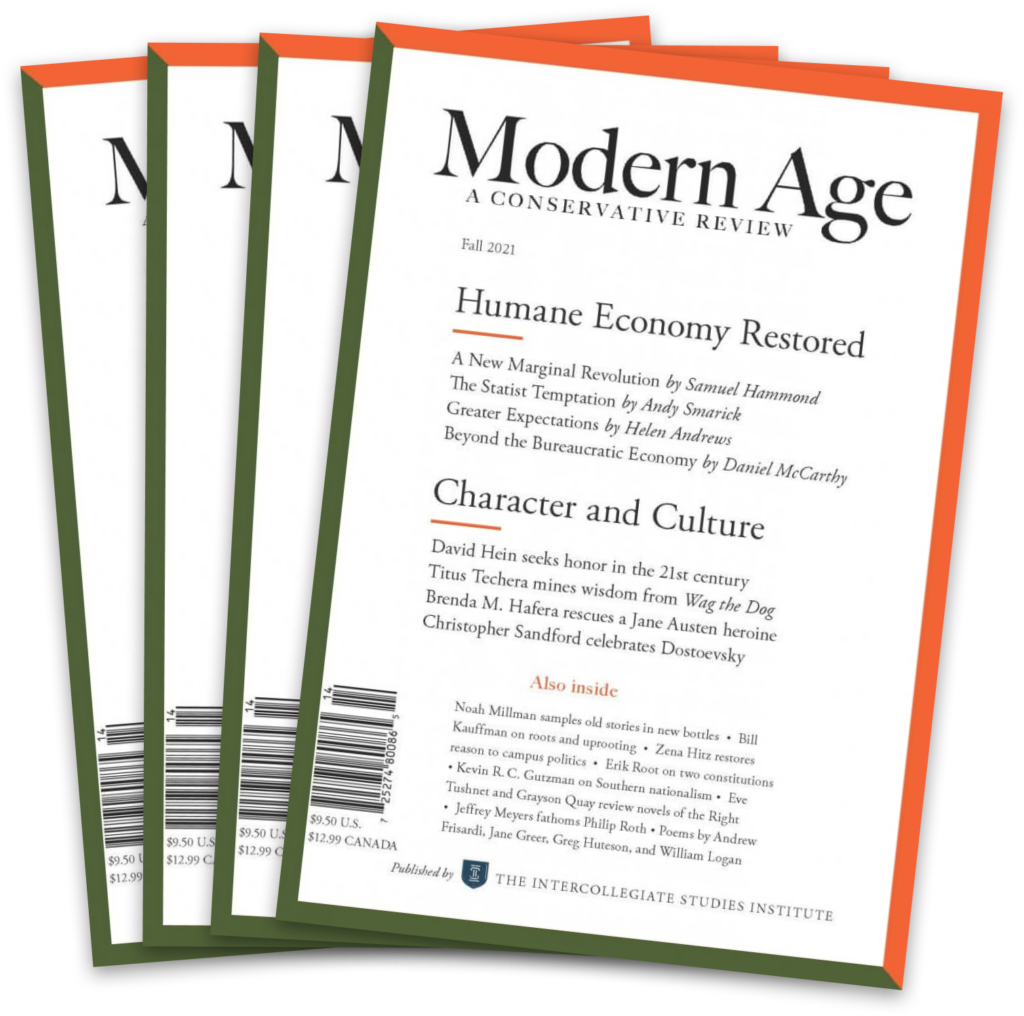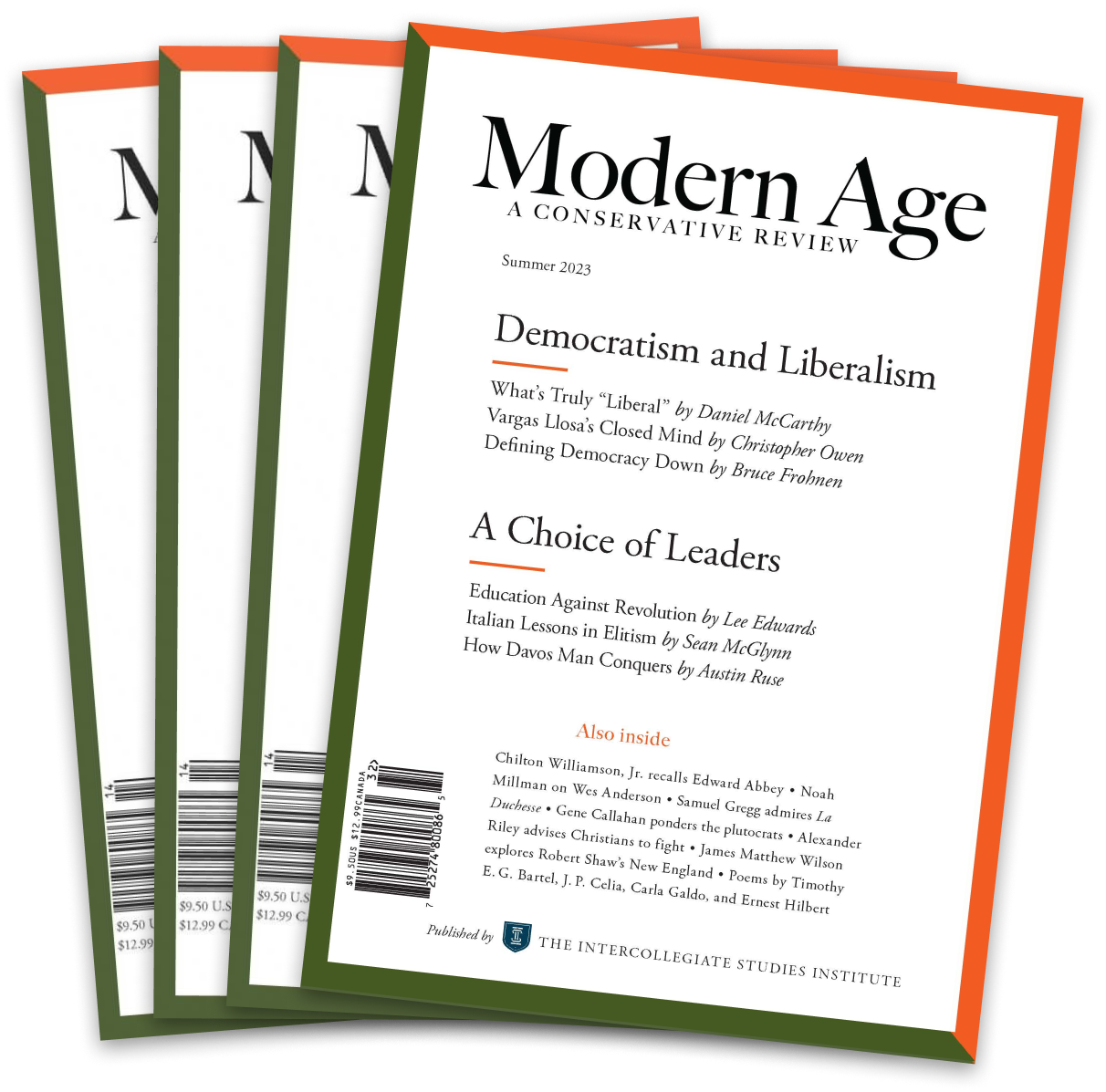Shortly before Christmas, I’m in an eleventh-grade classroom at Cardinal Kung Academy in Stamford, Connecticut. The academy is a Catholic school named for the renowned Chinese cleric who was imprisoned by the Communists in 1955, secretly made cardinal by Pope John Paul II, and upon his release moved to Stamford, where he lived for the rest of his life. Founded on a classical curriculum that features lots of Latin, Great Books, and the Magisterium, the school opened in 2018 with twenty students in two grades, ninth and tenth, and now has students in the sixth through twelfth grades. Its co-founder Nancy Grimm attended Thomas Aquinas College, as did her husband and siblings, and she wanted to create a middle- and high-school version of that formation. She—much like the growing ranks of parents and teachers who have started classical schools—reviewed public offerings nearby and found the learning there woefully inadequate.
A few weeks before my visit, I’d read a story in the Atlantic that contained a stunning announcement: “Many students no longer arrive at college—even at highly selective, elite colleges—prepared to read books.” The article had anecdotal accounts from Columbia and Georgetown universities of undergraduate students who can’t focus on a text with full attention, not even on short poems. A similar complaint appeared in the New Yorker in February 2023, with a Harvard professor telling the reporter that when she assigned The Scarlet Letter, undergraduates “were really struggling to understand the sentences as sentences—like, having trouble identifying the subject and the verb.”
In Mrs. Kimball’s class at Cardinal Kung, twelve students sit at desks arranged in a square. Each is equipped with paper, pencil, and book—no screens. The hour starts with all standing, facing the crucifix, and reciting the St. Michael prayer: “St. Michael the Archangel, defend us in battle . . .” A few minutes before, they and the rest of the school’s 120 students had been in the chapel downstairs saying three prayers in Latin, the boys in blue blazers and school ties and the girls in blazers, blouses, and skirts. The principal, Alexander Miller, had issued the day’s announcements, including word of a visitor (me) whose questions were to be answered with “honesty and politeness.” Back upstairs, I take a seat in the corner of the square as Kimball directs everyone to Book IV, line 288 of Paradise Lost, the moment Satan sneaks into the Garden and spies Adam and Eve (“Two of far nobler shape, erect and tall, / Godlike erect, with native Honor clad”).
Over the course of the next thirty minutes, an extraordinary discussion follows. Kimball is a Columbia English Ph.D. whose emphasis on close reading reminds me of undergraduate readings of Cleanth Brooks and W. K. Wimsatt. Every student contributes. One asks to what degree Milton’s narration is filtered through Satan’s consciousness; another comments on the double meaning of naked as both “unclothed” and “open/sincere”; others pause over loaded terms (“saw undelighted all delight,” “thy gentle hand / Seiz’d,” “Imparadis’d in one another’s arms”). The class jumps to Eve’s remembrance of when she awoke for the first time, bent over the pool, and spotted her own reflection, an allusion to Narcissus that the students pick up instantly. A girl points out the fact that Eve needs a man’s guidance, which sparks a short exchange on male–female inequality in the poem that hasn’t a whisper of feminist resentment. I tell Kimball afterwards that the session was the equal of an undergraduate seminar. These sixteen-year-olds are already habituated to “slow reading,” the very thing college teachers grumble that students lack.
The next class covers another classic, Dante’s Inferno, tenth graders this time, once again with books open and no screens. Mrs. Docherty begins at the beginning, the dark wood of Canto One. She details the landscape of hell, the rivers and the antechamber, Limbo, where the virtuous pagans reside, including Virgil. She pauses over these noble characters stuck below, and two students recall lessons from the year before by the chaplain, Fr. Joseph Gill, regarding the fate of those born before the first coming of Christ. Moses and Abraham get “harrowed” by Jesus right after the Crucifixion, but not these renowned Greeks and Romans—why is that? For another thirty minutes, discussion continues with no signs of boredom or disaffection. None of them seem to wonder why they must read a passage and comment upon it—it’s just what one does. The disposition has been instilled.
Mass takes place four times a week, and today it’s before lunch. The entire school sings “Come, Thou Long Expected Jesus,” incense hangs in the air, fourteen students make up the choir, the readings are 2 Corinthians and the parable of the ten virgins, and everyone lines up for Communion. A teacher taps two students in front of me who aren’t kneeling properly. Some of the girls wear veils. Father Gill notes that today marks the feast of St. Lucy, martyred as “a powerful light to the world,” before challenging the assembly: “How can you be a powerful light to the world?” My secular colleagues likely would judge the Mass to be an interruption in the school day, a distraction from math, English, and science. In truth, it’s the frame in which the entire curriculum unfolds. The Stations of the Cross that line the walls of the church tell a momentous story, a painting behind the altar announces “HERE THE WORD IS MADE FLESH,” and the priest urges the students to make time for prayer, “even if only for a minute.”
There is a structure to the cosmos, the school tells them: life is meaningful in a big way; transcendence awaits. Reminders arise throughout the day; every class opens with a prayer. I’m not sure the children fully understand what they’re being given, but that doesn’t matter; the effect is there all the same. One sees it in their tranquil faces as they line the main hallway beside their lockers at the end of the day and sing a closing hymn. It continues to astonish me that irreligious educators fail to recognize the value to teen hearts and minds of this teleological plan, which meets a psychological need that Nietzsche and his followers called “metaphysical comfort” or “ontological security.” The formality and ritual at Cardinal Kung reinforce faith in a God who cares.
The next class, Scripture, for ninth graders with Mr. DeFelice, inculcates another mode of mental training the visio divina (“sacred seeing”). He hands out a reproduction of a work from the early twentieth century, a lush painting of the Annunciation, and calls for four minutes of silent contemplation (he sets a timer). Some take notes, others stare, and two of the eleven drift a bit (a remarkably low number—to fifteen-year-olds, four minutes of hushed focus is like an hour). DeFelice asks the students to report what they see, and five hands go up. They mention the angel’s hair, the position of Mary’s arms, the colors dominating right and left, Mary’s expression (to which the teacher reminds them of the angel’s words in the Gospel: “Do not be afraid”), the direction of the angel’s hands, the deep shades of Mary’s dress, and the lilies in the angel’s right hand and the rose bush beside him, and one student discovers subtle signs of Mary’s divine motherhood.
It’s an unforced conversation. DeFelice doesn’t have to pull responses; the kids are eager, their remarks clipped and accurate. I list the details because they evince a crucial skill of analysis, in Matthew Arnold’s words, “to see the object in itself as it really is,” which may be the most important capacity in the makeup of college readiness. DeFelice hands out another page, the text of the first chapter of Luke, and asks students to identify the precise moment the painting captures. More silence for thirty seconds. They settle upon one verse, which completes the visio divina. “Reading and seeing are sort of the same,” the teacher tells them.
Art class comes next, a lesson in drawing that includes no “express yourself” elements. Instead, the teacher, who grew up in Ukraine under the USSR, maps the physical structure of the face. She sets a portrait photo of herself on a screen—the first technology I’ve seen—and draws lines to create a geometry of eyes, nose, mouth, cheeks, forehead, and hair. For example, the distance from base of nose to chin equals the length of the nose itself. This lasts for twenty minutes until she has students draw their own portraits with the command, “You must break your own face down mathematically.” No sentiment is encouraged, only technique. She assigns two of them to draw my face, adding, “Draw not what you think, but what you see.”
The final class of the day is AP Latin with Mr. Orazio, and the text is Book V of Caesar’s Gallic Wars. Orazio spent six years teaching Latin in public schools in Newton, Massachusetts, then moved to Italy to earn a license in Christian and classical literature from the Pontifical Salesian University in Rome before coming to Cardinal Kung in August 2023. His experience shows. The hour is an intense, fast-paced interaction with five students, sentence by sentence, word by Latin word, with Orazio inserting information here and there about military happenings in Gaul. Students toss “nominative” and “ablative of means” like budding experts. Few corrections need to be made. Next semester they will take on Virgil and the AP exam (Orazio also offers bits of advice about the exam’s format and graders).
Orazio isn’t the only ex–public schoolteacher or advanced degree holder at the school. Principal Miller has a Ph.D. in theology from Fordham University and has taught at the University of Notre Dame, Fordham, and St. John’s University, but he says he couldn’t be happier having left higher education for Cardinal Kung. Mrs. Kimball did her dissertation with Steven Marcus. The humanities teacher Emma Barnes earned a master of philosophy degree at Oxford and was in the middle of a doctor of philosophy degree when she decided to leave for Catholic middle school teaching. The Latin teacher Emil Bantea, who spent years in the public schools, says when I ask about the no-screens habitat at Cardinal Kung that in his old job technology was everywhere and served as a mask to disguise the lack of intellectual engagement in class. He commutes two hours a day and accepts a lower salary in order to work here.
It is tempting to label these teachers refugees from the mainstream and the school itself a counterculture. After the National Council of Teachers of English issued a position statement in April 2022 urging “English language arts” instructors to “decenter book reading and essay writing as the pinnacles of English language arts education” because our society is no longer “print-dominant,” after educators have devised learning standards that set “keyboarding skills” above handwriting, and after the National Council for the Social Studies has issued multiple statements insisting that teachers combat racism, transphobia, and so on in all of their instruction, a day at Cardinal Kung does indeed feel old-fashioned, disconnected, out of touch.
True—but only compared to common schooling in the United States. For years, we’ve heard that America needs more scientists and engineers: of the seven kids with whom I met over lunch, everyone had STEM plans for college even though their classical education was focused on the humanities. And the teacher turnover that plagues public schools doesn’t happen here. Miller says he receives frequent inquiries about possible openings from teachers far and wide. And the alarming articles about undergraduates who didn’t get a bookish formation in high school show how much elite colleges still prize the nondigital practices at Cardinal Kung. In the last five years in the United States, the percentage of students who met the ACT’s college readiness benchmark in reading fell from 45 to 40 percent; we may be confident that every graduate of Cardinal Kung belongs to that shrinking group of those who are prepared for the next level. The firm, omnipresent Catholic faith of the school appears ever more desirable, too, as young people in our country slide into nihilism and defeat.
This is a thriving counterculture, one that ought to be adopted in dioceses everywhere. Every bishop should support at least one classical Catholic school in his domain, if only to give parents a choice in the formation of their children. Indeed, classical schools, Catholic or not, should be supported regardless of one’s religious affiliation. All young people should read Milton, have a year or two of Latin, and realize that they’ve inherited a great tradition and inhabit a promising world. I have reported on in-class activity here because that’s the proof of quality, the place where a school’s value is best determined, not facilities, sports, tuition, or website. I offer in closing a word of advice to parents: visit local schools, watch the teachers at work, make comparisons, and measure the spiritual atmosphere and emotional mood. For Catholics, if existing choices come up short, tell your priest and show him a classical model such as Cardinal Kung. If that goes nowhere, then join with other parents and do what so many parents and educators have done in the last ten years: open your own school.














